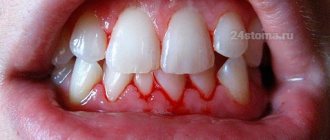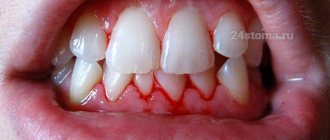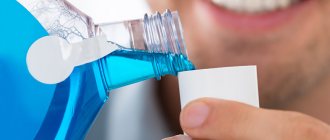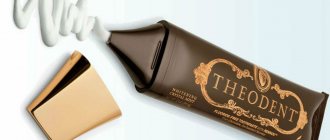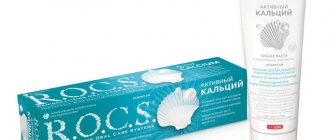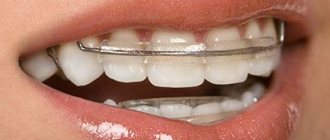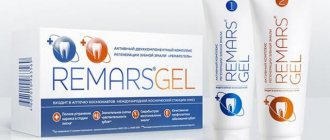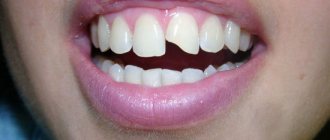When an adult’s tooth hurts and becomes loose, it is always pathological in nature and is not considered normal. Why do teeth become loose in adulthood?
There is a whole list of reasons:
- Gum pathologies. Inflammatory and infectious diseases of the oral cavity - periodontitis, gingivitis. They make the gums weak and cause bleeding. The tooth root weakens and the teeth begin to hurt and move.
- Hidden chronic diseases. Sometimes a tooth hurts and becomes loose due to hidden chronic pathologies. For example, with inflammatory processes in the joints, including jaw joints, arthrosis, endocrine disorders, weakening of the cardiovascular system, calcium deficiency, tumors.
- Carrying a child. Hormonal imbalance and a decrease in the amount of calcium in the blood can lead to loosening of molars and their loss.
- Mechanical damage. Impacts, scratches and other damage to the jaws can cause loosening. Especially if inflammation has developed in the area of damage.
You can strengthen loose molars by regularly using preventive measures:
- Periodically clean from stones and plaque.
- Quit smoking.
- Eat fully and correctly.
- Clean your teeth with strengthening agents.
- Do not start inflammation in the oral cavity.
- Take calcium supplements.
In addition, you need to undergo a dental examination at least once a year.
If the tooth is a little loose
If your teeth have just begun to loosen, then you need to urgently take preventive measures. If you don’t know why your teeth have become loose, then it’s better to see a doctor for control.
What to do after being examined by a doctor:
- Brush your teeth and rinse your mouth twice a day.
- Correct the bite if there is deformation.
- Monitor the condition of your gums.
- Eat right, including vegetables, fruits and foods rich in fluoride and calcium in your diet.
These methods will help strengthen your teeth and prevent further loosening.
Top 8 harmful foods
Lists of healthy food ingredients have been studied for a long time and represent a wide range. But there are also components harmful to teeth that quickly destroy enamel and contribute to the loss of healthy teeth due to weak gums.
These products primarily include:
- Sugar and sweets, except honey. They disrupt the acid-base balance in the mouth, contribute to pathological processes and quickly destroy enamel.
- Caffeine. The beneficial components are washed out and the body becomes dehydrated.
- Roasted seeds are not beneficial when brushing your teeth. They mechanically damage the enamel.
- Pieces of dried fruit , if you do not brush your teeth immediately after eating, get stuck in the space between the teeth and disrupt the acidity.
- Sugary drinks provoke inflammatory processes.
- Temperature changes and eating hot and cold food at the same time lead to rapid deterioration of teeth.
Food that is too hard and too soft will not be beneficial. They help reduce the strength of enamel and gums. This greatly impacts your overall oral health.
Part of the molar is movable
Teeth can become loose and fall out in parts. When half a tooth is loose, the dentist takes an x-ray to determine whether the root is affected or only the outer part of the crown is damaged. If the root is not damaged and the base is preserved, then it can be saved. The upper part of the crown is removed and a pin is installed in its place. Then extension is carried out. If the pin cannot be placed, then a polymer filling is placed, and a crown is placed on it. When a tooth becomes very loose and the root is crushed, it is removed and an artificial crown is placed in its place.
Gum disease - periodontitis
While gingivitis responds well to treatment, periodontitis, which is a consequence of untreated gingivitis, is a much more dangerous and complex disease. Periodontitis is characterized by extensive inflammation, swelling, the appearance of purulent sacs and, most importantly, atrophy of the alveolar processes, leading to exposure of the neck of the tooth. The causes of periodontitis are much the same as those of gingivitis. Periodontitis can also be a concomitant manifestation of diseases such as HIV, diabetes and leukemia. There are several stages of periodontitis, each of which has its own nuances.
- Easy.
Accompanied by pain, bleeding gums, and bad breath. - Average.
At this stage, an increase in periodontal pockets occurs, there is loosening of teeth and an increase in interdental spaces, as well as pain when eating and performing hygiene. - Heavy.
There is a significant deepening of the pockets (5 or more millimeters) and exposure of the neck of the tooth, as well as severe pain, bleeding, and purulent discharge. In the most advanced cases, bone tissue damage and tooth loss occur.
What to do after a blow
Dental bruises are closed injuries received after strong mechanical impact. (hitting a hard object). In this case, the teeth remain in place, do not move, but may begin to move. The front ones are especially vulnerable. If your front tooth becomes loose after an impact, you should immediately consult a doctor so that you can save it. X-rays and electroodontodiagnosis are prescribed. The latest diagnostic method makes it possible to see the beginning of the development of tissue necrosis and remove dying particles to prevent inflammation.
As a rule, medications are not used for tooth bruises. Swelling of the gums is relieved with cold compresses, and the patient must be on a liquid diet for some time to keep the molar at maximum rest. Sometimes, dentists practice grinding the cutting edge of the tooth and the cusps of the opposite tooth on the lower jaw, which the patient touches when chewing food.
Gingivitis is a gum disease in adults
Gingivitis is the most common gum disease, but also the least dangerous of the other two. This name comes from the Latin word gingivitis, which translates as “inflammation of the gums.” Of course, modern dentistry highlights more specific features and symptoms of this disease. Despite the fact that gingivitis is much easier to treat than periodontitis and periodontal disease, the lack of timely treatment can subsequently be costly for the patient, both in terms of treatment costs and in terms of overall health. The main causes of gingivitis lie, first of all, in improper hygiene or its complete absence. This disease can also occur due to mechanical or thermal injuries to the gums, a weakened immune system, and improperly performed dental prosthetics. Gingivitis is a shallow inflammation of the gum line around one or more teeth, but this is just general information. There are several forms of gingivitis that need to be briefly mentioned.
Catarrhal
The most common form of gingivitis, it is characterized by redness of the gums around one or more teeth. Often accompanied by bleeding gums, mild itching, pain when eating and performing hygiene.
Hypertrophic
With this form of gingivitis, significant compaction and growth of gum tissue is observed, up to the keratinization of individual areas. The color of soft tissue becomes dark red. With this form, treatment of the gums between the teeth is often required.
Ulcerative
One of the most severe forms, in which large areas of the gums are affected and a characteristic gray coating appears. In an advanced stage, it can be accompanied by purulent inflammation, death of soft tissue areas and bad breath.
If the root one is unsteady
Often a healthy tooth begins to hurt sharply and become loose. Permanent teeth can also become loose, even if they are molars. You don’t need to endure it, but go to the dentist. The doctor prescribes disinfectants: rinsing with chlorhexidine and furatsilin solution, gel applications.
If the gums are inflamed, then anti-inflammatory and regenerating drugs are prescribed. (“Trental”, “Olazol”, etc.). Physiotherapy also helps stop the process. For example, vacuum massage, darsonval, ultrasound procedures.
After stopping the inflammatory processes in the oral cavity, the dentist strengthens the teeth in the correct position and applies a temporary splint. If a wisdom tooth is loose and hurts, it is most often removed since it does not play a special role in the chewing process.
Methods of treating gums with periodontal disease
When treating periodontal disease, you must first try to identify and eliminate the root cause of the disease. To do this, a comprehensive clinical study is carried out and a treatment plan is drawn up based on its results. The patient may be prescribed biostimulants designed to improve the body's immune system, general therapy medications, as well as medications that improve blood circulation. As for the direct effect on periodontal tissue, several techniques are used here.
Method of treating gums
For the treatment of periodontal disease, darsonvalization (exposure to high-frequency pulsed currents), laser therapy, and electrophoresis (a combination of drugs and electric current) are actively used. Another way to treat gums is vacuum therapy.
Treatment of gums with injections
In the case of periodontal disease, medications are administered through injections for greater effectiveness. Most often these are injections with glucose solution, hydrogen peroxide and antibiotics.
Surgical treatment of gums
In the case of periodontal disease, medications are administered through injections for greater effectiveness. Most often these are injections with glucose solution, hydrogen peroxide and antibiotics.
Transplantation of soft and hard tissues is also practiced, but this measure does not bring a positive effect in all cases. This is due to individual characteristics, as well as the fact that periodontal disease is still not a fully understood disease.
Treatment and preventive measures
To restore blood supply and tone of the soft tissues of the oral cavity, gum massage is performed. It can be hardware or manual.
Front
The upper front teeth are very mobile, so they often begin to wobble. To find out the reason for this, a comprehensive examination is carried out, including a panoramic photograph of the oral cavity. What to do if your front molar is loose?
After determining the causes, a complete sanitation of the oral cavity is required to destroy infectious pathogens. If periodontal disease is detected, the specialist performs a special massage on the gums, darsonval procedures. If signs of periodontitis are detected, then be sure to remove stones and plaque, and polish the teeth with an ultrasonic beam. The entire surface of the tooth, including the neck, is polished with a brush using medical varnish containing fluoride.
Difficult deposits are removed with curettes, which pass under the gums, pulling out deposits. Open curettage is also performed, where the gum is cut and then stitched back together. Additionally, medications are prescribed that relieve inflammation with an antiseptic effect.
If the upper front teeth of an adult are seriously damaged or separated, a splint is placed on the upper jaw. A small hole is drilled in the molar into which fiberglass is placed. After which everything is covered with any composite substance that reflects light rays. Thus, during the movement of the front jaw, the molars do not move apart.
In the event of a mechanical injury, when part of the crown is broken and the tooth root is damaged, all fragments are removed and artificial crowns are installed in place of the natural tooth. The sooner a patient contacts a dentist with a problem, the higher the success of treatment. In complex cases, surgery may be required.
Treatment of gums and oral cavity with periodontitis
When gums hurt, treatment of periodontitis is almost always complex and depends on the severity of the disease and its specific manifestations. The difficulty is that periodontitis can be treated well only in the early stages: when the disease is in severe form, it is very difficult to cure it. Below are the current techniques that are used to effectively treat gums today.
| Stage of gum disease | Treatment |
| Easy stage | Cleansing teeth from plaque and tartar, as well as antiseptic treatment. Additionally, antibiotics, vitamin complexes and special hygiene products may be prescribed. |
| Stage of gum disease | Treatment |
| Middle stage | At more serious stages, it is almost always necessary to take antibiotics (lincomycin, clindamycin and others), and periodontal pockets are also treated (deephalization). A carbon laser is best suited for this purpose, as it effectively clears the affected tissue from the area and promotes faster healing. |
| Stage of gum disease | Treatment |
| Severe stage | The stage of the disease that is most difficult to treat. The most effective method of treating severe periodontitis is curettage. This is a surgical procedure where the doctor makes an incision along the gum line and cleans out the pockets of granulation tissue and dental plaque. Often, when teeth are loose, splinting is required, and in case of extensive damage to bone tissue, bone grafting is required. However, even such measures do not always provide a positive result. |
Patients often note that their gums hurt after treatment. This is normal, especially after surgery, but if the pain is much worse than usual and does not go away for a long time, we recommend notifying your doctor.
What to do if your teeth are loose and your gums hurt
When gums bleed and become inflamed, teeth can also become loose and even fall out. One of the factors that provokes this condition is acute or chronic gingivitis. The inflammatory process provokes a light plaque on the teeth consisting of microbial pathogens or the formation of tartar on the teeth if you do not take good care of the oral cavity. If gingivitis is not treated, the germs travel deeper into the tissue. Periodontitis develops when pus forms on the gums, the necks of the teeth are exposed, and constant pain appears.
With periodontitis, the inflammatory process occurs in the tissues, from the base of the tooth root. At the same time, gumboil appears and the gums become very swollen and painful. Sometimes, due to chronic infection, cysts form on the gums; they do not appear immediately. In severe cases, a granuloma forms on the gums, in which bacteria attack the gums and roots of the teeth. In this case, the person experiences severe itching and high fever.
Also, gums can hurt after tooth extraction, installation of implants, braces, appliances, or improper dental treatment.
If your teeth are loose in your gums, you should not:
- Press your finger on the gum
- Heat with compresses, sand, warm rinses
- Open an abscess at home
- Taking too many painkillers
First of all, you need to relieve pain with pills or injections. But under no circumstances should you exceed the dosage. Paracetamol, analgin, ketanol and other similar products are suitable. You can also use gels with an analgesic and cooling effect.
You can rinse your mouth with Chlorhexidine and Miramistin. This needs to be done in the morning at lunch and in the evening to get results.
Methods and methods for self-treatment of gums at home
If you cannot make an appointment with a dentist to treat your gums, self-treatment of your gums should be done in stages. First of all, it is necessary to relieve pain, then swelling and bleeding in the gums. You can prepare a remedy for gum inflammation yourself. An effective natural remedy for sore gums must be fresh, its shelf life does not exceed 24 hours after brewing. For self-treatment of gum inflammation, you can use decoctions, infusions, ointments, fresh extracts and plant oils. Medicinal products for strengthening gums and teeth are used as solutions for mouth rinsing and as solutions for applications, which should remain in the diseased gums for a certain time, about 20 minutes. The herbs included in the gum rinse for inflammation can be either fresh or dried. Rinse for teeth and gums during inflammation should be regular, preferably at the same time, throughout the entire period of treatment. On average, a course of gum treatment with folk remedies takes 1 – 2 weeks.
General scheme (method) for treating gums at home:
- First we remove swelling and inflammation.
- This requires astringents and antibacterial agents. For example: rinsing with saline solution 2 times a day, calamus root infusion 2 times a day, oak bark decoction 2 times a day, hydrogen peroxide 2 times a day. After each rinse, apply amaranth oil to the sore gum for 20 minutes.
- After 4 - 6 days we change the drugs.
- As the swelling and inflammation subside, keratoplasty drugs are needed. If there is no allergy, we use fresh propolis (not an alcohol tincture of propolis, but propolis oil) for applications to the gums 2 times a day in the morning and evening, during the day we apply sea buckthorn or rosehip oil. We also continue to use amaranth oil, but now in addition to compresses on the gums, also 1 tablespoon inside in the morning and evening.
If the cause of inflammation of the gums is a sore tooth, then swelling of the gums can develop into periostitis (flux), and pus accumulates in the mouth under the gum. This condition is life-threatening, because the spread of pus can go into the internal cellular spaces of the neck and floor of the mouth and be complicated by phlegmon. Such purulent processes are accompanied by high fever, weakness and dizziness, sweating and chills. Therefore, if you are in the city, be sure to consult a doctor. If you are hiking in the forest or mountains and there is no doctor, you need to take broad-spectrum antibiotics or fluoroquinolones (for example, Rulid, Avelox) and, if possible, ensure evacuation by the police or the emergency services of the Ministry of Emergency Situations to the maxillofacial department of the hospital.
Ask a question!
8
We'll call you back in 1 minute
Hydrogen peroxide solution for rinsing
What strengthens weak gums due to bleeding caused by removable acrylic dentures? This is the well-known and accessible hydrogen peroxide! Prepare a mouth rinse solution. You will need hydrogen peroxide (you can buy it at a pharmacy, usually a 3% solution) and water. Add a tablespoon of peroxide to a glass of water. The solution is ready. Rinse throughout the day, three or four times will be enough.
Oak bark for gums: a homemade recipe
Oak bark is one of the remedies that helps to effectively and in a short period of time get rid of bedsores and ulcers caused by wearing dentures and other problems associated with the gums and oral mucosa. In order to prepare the decoction you will need 500 grams of water and oak bark, about 2 tablespoons (pre-grind). Cook the bark over low heat for a quarter of an hour. Leave for 20 minutes. Rinse your mouth with the strained solution.
Rinse with soda for gum inflammation
Baking soda is useful for treating gums at home. We will prepare a soda-based rinse solution. You will need 200 grams of water, a teaspoon of soda, a pinch of salt and a sage decoction (about 50 grams). Mix the ingredients. Rinse at least four times a day.
Herbal rinse solution
If gums are bleeding due to the edges of metal-ceramic crowns, the following solution may be useful: you will need a spoonful of the following herbs: St. John's wort flowers, elderberry and strawberry leaves. Boil the mixture over low heat for 15 minutes, remove from heat. Infuse the decoction for 40 minutes. Rinse your mouth every 2 hours during the day.
Rinse your mouth with St. John's wort infusion
Take a spoonful of herbs, pour boiling water, 200 grams will be enough. Leave for 40 minutes. Strain and rinse your mouth.
Aloe for gum inflammation
Aloe compress: wash the plant leaf, remove the thorns and cut lengthwise. Apply to gums for 15 minutes.
Saline gum rinse
To prepare, you will need salt (it is better to use sea salt), one tablespoon and water, approximately 150 grams. Rinse your mouth with the solution a couple of times a day. You can simply rub salt into your gums. Sea salt relieves inflammation.
Chamomile and calendula for gum inflammation
Self-treatment of gums at home - chamomile and calendula. These plants relieve inflammation well. To prepare the infusion, you will need a tablespoon of chamomile or calendula, pour boiling water over the herb (a glass will be enough). Let it brew. Strain. Alternate infusions.
Let's prepare an infusion of pine buds for gums
To prevent gum inflammation when wearing zirconium crowns, we prepare an infusion of pine buds. This relieves redness and inflammation from irritated areas of the gums. You will need a tablespoon to chop the kidneys. Pour water (you will need half a liter) and boil for 10 minutes. Leave for an hour. Rinse with strained infusion.
Propolis: alcohol tincture for gums
Treatment of gums at home is also possible with an alcoholic infusion of propolis. Add 20 drops of tincture to a glass of warm water and you can begin the rinsing procedure.
Calamus root
To prepare a solution for rinsing, you will need calamus root (a tablespoon of crushed), pour boiling water (200 grams). Let it brew and you can use it. This type of solution copes with inflammation and removes unpleasant odor from the mouth or from under dental crowns.
Honey + salt
One of the well-known and useful methods of relieving inflammation is a mixture of honey and salt (preferably sea salt, of course). To prepare, you will need a spoon of honey and 4 tablespoons of salt. Mix all ingredients. Rub the mixture onto problem areas of the gums.
Black radish
You can treat gums at home at any time. If you have black radish at home, then this is a great way to get rid of bleeding gums. Extract the juice from the fruit and rinse your mouth with it.
Decoction: linden flowers and oak bark
To prepare an effective decoction you will need two tablespoons of crushed oak bark and a spoonful of linden flowers. Mix everything, you get a mixture. Take a spoonful of the mixture and fill it with water (200 grams will be enough). Let it boil for 2 minutes, leave for 20 minutes. Rinse your mouth with warm, strained broth. Thanks to oak bark, the effect will be noticeable after the first procedure.
Nettle leaf decoction for gums
Let's prepare an infusion (decoction) of nettle leaves. You can use fresh or dry leaves and the effect is the same. Just be careful when chopping fresh leaves. To prepare, you will need to pour a spoonful of crushed leaves of the plant with water (200 grams of boiling water). Leave the solution for 30 minutes. Rinse your mouth at least three times a day. To avoid treating inflammation and bleeding gums, eat more vegetables and fruits. Watch your diet. Do not abuse alcoholic drinks and smoking. Be sure to use dental floss after eating or simply rinse your mouth well. Remember that oral hygiene in the morning and evening will help avoid problems with gums and teeth. You can use gum treatment at home, that is, traditional methods, together with medications.
This article is for informational purposes only and does not encourage you to treat your gums at home. We strongly recommend using the recipes described above only after consulting a doctor.
Our doctors
Brodsky Sergey Evgenievich
Deputy Chief Physician, Candidate of Medical Sciences, specialties: dentistry and medical microbiology.
Work experience: since 1999.
Salatsky Dmitry Nikolaevich
Chief physician, orthopedic dentist, gnathologist, maxillofacial prosthetist.
Work experience: since 1988.
Kolikov Dmitry Vladimirovich
Dentist, implant surgeon, orthopedist, therapist
Work experience: since 1999
Skranzhevskaya Svetlana Vladimirovna
Hygienist, dental assistant
Work experience: since 1994
Seredin Evgeniy Vasilievich
Implant surgeon
Work experience: since 2004
Malanova Olga Andreevna
Dentist, orthodontist, therapist
Work experience: since 2016
Rybakova Tatyana Evgenevna
Dentist-therapist-endodontist
Work experience: since 2006
Molodtsov Dmitry Evgenievich
Osteopathic dentist
Work experience: since 1998
Artemyeva Oksana Alexandrovna
Orthopedic dentist, therapist
Work experience: since 2001
Just pick up the phone and call us!
8
We will definitely make you an offer that you cannot refuse!
Medicine for rinsing
How not to make a mistake when choosing a gum rinse? To do this, you must strictly follow the instructions of your doctor. Most often, dentists recommend using the following ready-made pharmaceutical preparations.
- Rotokan.
A popular tincture for rinsing gums, which contains exclusively plant extracts. Has antimicrobial and wound-healing effects. Rotocan for rinsing gums requires dilution with water. - Chlorhexidine.
A universal remedy aimed against both bacteria and viruses and fungi. The recommended concentration of chlorhexidine for rinsing gums is 0.25 mg/ml. Please note that if you use it for longer than 5 days, the color of the enamel may change. - Furacilin.
These yellow tablets are familiar to many from childhood: furatsilin is used to rinse the gums and throat for inflammatory diseases of the upper respiratory tract. When preparing a solution from crushed tablets, you must remember that the water must be hot, otherwise the dissolution will take a long time.
How much does gum treatment cost in Moscow?
We can only talk about prices for gum treatment in Moscow in a general way, since everything depends on the disease and its specific manifestations. For example, treatment of simple gingivitis with a diode laser will cost on average 1,000 rubles per tooth, and complex therapy for periodontitis costs 10,000 - 20,000 rubles per jaw (depending on the stage of the disease and the level of the clinic). In this case, medications, antibiotics and hygiene products are paid for separately by the patient. As for complex periodontitis and periodontal disease, it is difficult to give even an approximate amount of treatment. For this, curettage is often used (1,000 - 2,000 rubles per tooth), as well as plastic surgery of hard and soft tissues: the cost of this surgical procedure depends on the volume of treatment and the drugs used. If the patient’s teeth are very loose, the doctor usually suggests splinting, which on average costs 2,000 rubles per tooth.
